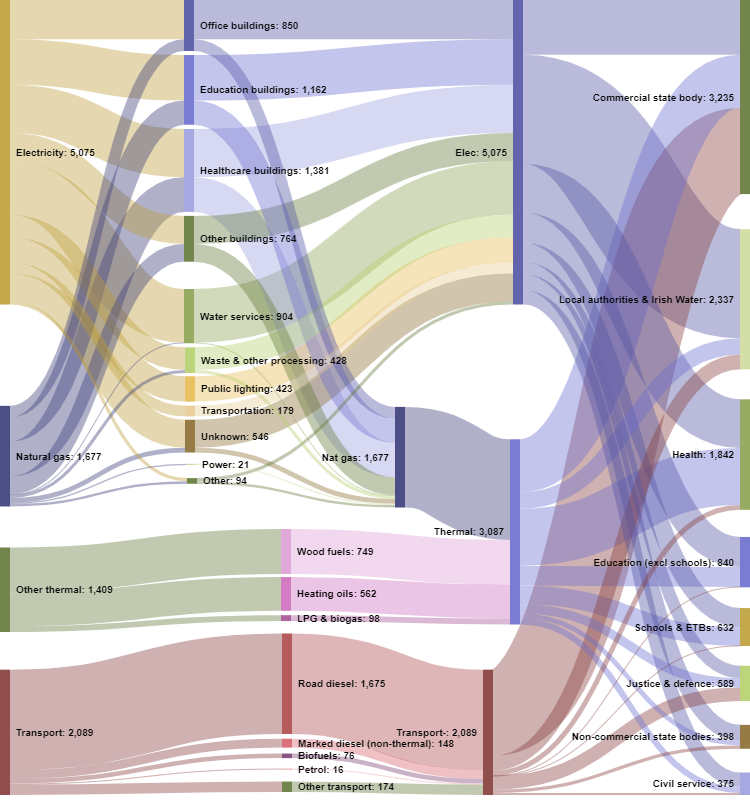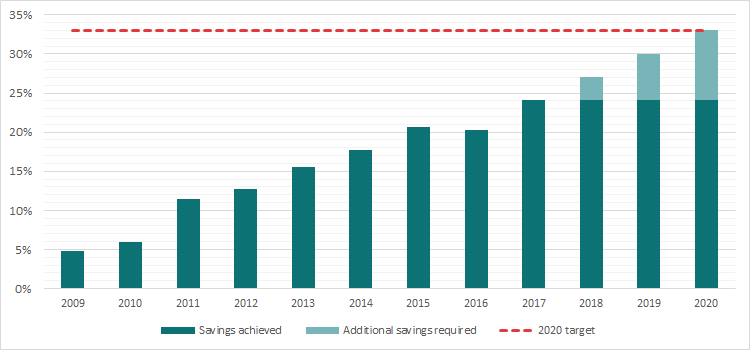
The Sustainable Energy Authority of Ireland (SEAI) recently launched the Government's latest annual report on public sector energy performance. The report provides data on energy consumption and energy performance throughout the sector.
Diverse sector
While the sector is much smaller than the industrial and residential sectors in terms of energy use, it spends €608 million per annum on energy, and comprises over 46,000 metered energy connections (electricity & gas). The scope of the sector is quite diverse in terms of both energy consumption and constituent organisations, in that it includes offices, hospitals, schools (~4,000), colleges, water services facilities, public lighting, public transport and other transportation services. It includes several large commercial state bodies (e.g. ESB, Coillte, Bus Éireann), the civil service, local authorities and numerous state agencies, as well as several charities that provide services on behalf of the State (e.g. in the health sector).
Potential for savings
The sector has an ambitious target of a 33% improvement in energy efficiency by by 2020 (compared to 20% for the wider economy). According to the Department of Communications, Climate Action & Environment's Public sector energy efficiency strategy (January 2017), achieving the 33% target 'would see the public sector avoid €246m in energy spend in the year 2020 and avoided CO2 emissions of 5.9m tonnes for the period 2009-2020.'
Energy consumption
The sector used just over 10,000 GWh of primary energy in 2017, 96% of which was consumed by 331 public bodies and 2,279 schools that submitted consumption data to SEAI through its monitoring & reporting system. Our sankey diagram below summarises the key consumption data that has been published.
Public sector energy consumption 2017 (source: SEAI)

Notes: all values are expressed in GWh of primary energy; ETBs = education & training boards; some rounding differences in subtotals.
The following are some headline figures derived from the report:
- Half of public sector consumption is electricity, with thermal energy accounting for 30% and transport 20% (on a primary energy basis).
- Almost 70% of transport consumption is in the commercial state sector, which includes the four state-owned transport companies.
- Altogether, buildings account for about half of energy use.
- 36% of electricity consumption is in the local authority & water services sector (i.e. including Irish Water). Water services facilities consume 18% of all electricity used (9% of total energy), while public lighting accounts for just under half this amount.
- The top 10 organisations are responsible for over half of total consumption.
- 34 organisations consume over 50 GWh per annum and together account for almost 70% of consumption: the HSE, four Dublin-based voluntary hospitals, six universities, the four state-owned transport companies, seven local authorities (4 x Dublin, Cork County, Donegal), two government departments (Agriculture, Social Protection), RTÉ, Coillte, ESB, Irish Water, An Garda Síochána, the Defence Forces, Irish Prison Service, An Post, Dublin Airport, OPW and the Revenue Commissioners.
- The health sector accounts for 18% of overall consumption and 31% of thermal energy consumption, including 35% of natural gas consumption.
Energy savings
The 33% target applies to all public bodies, i.e. each organisation has a target to achieve a 33% energy efficiency improvement by 2020, compared to a defined baseline period. The SEAI report reveals that of the 331 non-school public bodies that reported data, 90% have improved their performance since their baselines and over half (59%) are 'on track' to meet their 33% target.
Overall, the sector has improved its energy performance by 24% by 2017, up from 20% in 2016. It is therefore just over two thirds of the way to meeting its 33%-by-2020 energy efficiency target. While the report acknowledges that this is a 'good result' and the graph below shows how the sector is back 'on track' after a slight deterioration in 2016, there are significant challenges ahead for public bodies to bridge the gap to the 2020 target. The scale of this challenge is illustrated below - the light green bar shows the additional savings required to reach the target, on the basis of a steady trajectory to 2020.
Improvement in public sector energy efficiency 2009-2017 (source: SEAI)
Achieving the 33% target would be equivalent to 4,446 GWh of primary energy savings. The annual savings achieved by 2017 amount to 3,223 GWh, which is equivalent to €191 million of avoided expenditure and 667,000 tonnes of avoided CO2 emissions per annum.
It is expected that more ambitious targets will be announced soon for the period to 2030.
Sectoral & organisation-level data
Since late 2018, SEAI has published significantly more detailed energy data for the public sector on its website, including sectoral breakdowns, searchable organisation-level consumption data and a searchable database of energy-saving projects reported by public bodies.
This insight is based on our analysis of SEAI's latest data (2017) and replaces previous articles that analysed 2015 & 2016 data. Our 2015 & 2016 sankey diagrams are available here and here respectively.
The SEAI report is based on analysis undertaken by Byrne Ó Cléirigh and summarises data that has been submitted through SEAI's public sector energy monitoring & reporting (M&R) system. Byrne Ó Cléirigh played a lead role in the development of this system and continues to work closely with SEAI on its implementation and ongoing development.
